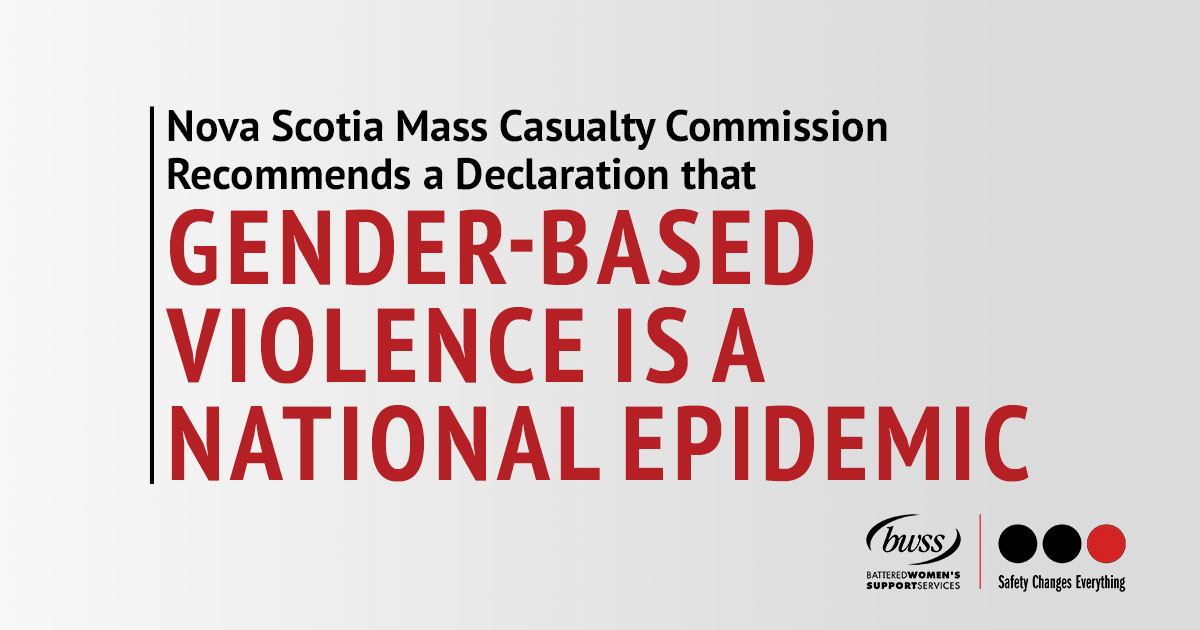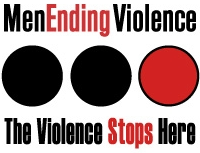Earlier this year, the Nova Scotia Mass Casualty Commission released its final report, titled Turning the Tide Together.
The Mass Casualty Commission was a joint public inquiry between the Governments of Canada and Nova Scotia created to examine the April 2020 mass casualty in Nova Scotia.
This mass casualty was one of the largest mass murders in Canadian history, in which a sole perpetrator, Gabriel Wortman, killed 22 people throughout rural Nova Scotia over a 13-hour period while dressed as an RCMP officer and driving a mocked up RCMP cruiser.
Gender-Based Violence is a Mass Casualty
The commission’s findings, final report, and over 130 recommendations focus on how to increase community safety and to prevent such a tragedy from happening again.
A key theme throughout the report is the pervasive context of gender-based violence giving rise to the mass casualty and the failed actions of the police.
The Commission stress that the strong connection between gender-based violence and mass casualties cannot be overlooked.
The Commission finds four main connections between gender-based violence and mass casualties:
- Perpetrators frequently target a specific woman at the outset of a mass casualty incident. Often, this is the perpetrator’s current or former intimate partner, a woman with whom the perpetrator wanted to have an intimate relationship, or a family member.
- Many perpetrators have a history of gender-based violence including intimate partner violence, coercive control, sexual assault, stalking, and harassment.
- Some mass casualties have been overtly motivated by hatred of women in general or by a belief that women don’t deserve respect, security, or equality.
- Some mass casualties are motivated by misogyny intersecting with other forms of extremism.
Disturbingly, the Commissioners found there were many warning signs of Wortman’s history of gender-based violence and several missed opportunities to intervene in the years before the mass casualty.
For example, he was known among sex workers as someone who exchanged dental work for sex and who routinely violated sex workers. He also had a history of violent behaviour against his patients, neighbours and his common-law spouse, Lisa Banfield, who was in a twenty-year abusive relationship with him and endured physical abuse and violent assaults.
The Commissioners found that the RCMP failed to take meaningful action on third-party reports of assaults by Wortman on Ms. Banfield and didn’t act on concerns for Ms. Banfield’s safety that were expressed by her neighbours dating back to 2013.
In addition, the Commissioners acknowledged the victim-blaming faced by Banfield during the relationship, and even in the months following the mass casualty. “The RCMP’s treatment of Lisa Banfield during the RCMP’s H-Strong investigation [of Wortman] is an example of the kind of revictimization that makes it less likely that women survivors of gender-based violence will seek help from police,” says the report.
The Commissioners found the failure of the police to respond to this extensive history of violence as a failure “to adequately address gender-based violence.”
In their extensive discussion of gender-based violence, the Commission noted that Wortman’s pattern of violent behaviour was facilitated by the power and privilege he experienced as a white man with professional status and substantial means. Conversely, they also highlighted that “economic marginalization and criminalization heighten the risk of violence against women and girls.”
They specifically point out how “Indigenous women and girls, Black and racialized women, immigrant and refugee women, 2SLGBTQI+ people, people with disabilities, and women living in northern, rural, and remote communities are disproportionately subjected to violence,” and that, further, “the consequences of reporting violence can deepen their experience of inequality.”
This is a crucial recognition of the systemic, intersectional nature of gender-based violence that exists on a spectrum of intimate partner violence, family violence, and gendered state violence.
Key Recommendations of the Mass Casualty Commission
“Redressing our collective failure to keep women safe will mean shifting public funding toward prevention – toward addressing the upstream problems, including the causes of male violence and the social and economic conditions that perpetuate women’s vulnerability to violence.”
Some of the specific recommendations of the Commission include:
All levels of government must declare gender-based, intimate partner, and family violence to be an epidemic that warrants a meaningful and sustained society-wide response. Recognizing and addressing root causes that contribute to vulnerability to violence includes addressing gender inequality, marginalization, and precarious status.
A whole of society response includes a range of actors contributing to ending the epidemic of gender-based violence, including federal, provincial, territorial, municipal, and Indigenous governments; the health sector and the justice system; the non-governmental and community-based social services sector; businesses, and workplaces; media; schools and educational institutions; communities; and individuals, including survivors and perpetrators. A whole of society response respects and values the expertise and experience of survivors and the gender-based violence advocacy and support sector.
Epidemic-level funding for gender-based violence prevention and interventions is needed. Community-based services, and in particular services provided by the GBV advocacy and support sector, need to be viewed in tandem with police agencies as equal partners in preventing violence. These services are front-line public services and are not discretionary, and funding should be commensurate with the scale of the problem.
Priority should be placed on providing adequate and stable core funding to organizations in the GBV advocacy and support sector. Funding should prioritize prevention and provide women survivors with paths to safety.
Governments should adopt funding allocation methods for community safety and well-being initiatives that take into account rural and remote contexts. This funding should be long-term core funding for services that are known to be effective in meeting the needs of women survivors of GBV and that contribute to preventing it, including interventions with perpetrators. The priority should be on funding community-based safety resources and services within communities where marginalized women are located.
Enacting Community Safety and Well-Being Laws that center equality and inclusion; takes a prevention-first approach; are based on social determinants of health, and de-centers policing. These laws should recognize gender-based, intimate partner, and family violence as a central inhibitor of community safety and well-being; prioritize safety and well-being in marginalized communities, recognize the past and ongoing collective trauma resulting from systemic racism, colonialism, and other processes of marginalization and oppression; and ensure that rural communities have an active role in planning for safety and well-being in their communities.
An external, independent review of the RCMP, including a review of the contract system under which the RCMP provide policing services to much of rural Canada. There should be an additional review of the RCMP’s critical incident response training.
New community-based systems and safe spaces for reporting gender-based violence must be developed to respond to the safety needs articulated by women. Many women do not report violence to the police because they believe or know that the criminal justice system is not a safe route to escape danger. Governments, service providers, community-based organizations, and the GBV sector must take a systemic approach to learning about and removing barriers to women survivors, with a focus on the diverse needs of women who are vulnerable as a result of their precarious status or situation. Community-based reporting systems should center the safety of survivors.
Shifting to a focus on putting women’s safety necessitates decentring the criminal justice system. Law enforcement is only one part of the response to violence, and a public health approach has primary prevention rather than criminal justice as its focal point. Mental health crisis response should be reallocated to trained, adequately funded mental health care providers. Federal, provincial, and territorial governments should develop a national action plan to promote better integration of preventive and supportive mental health care. Governments should also shift priority and funding away from carceral responses and toward primary prevention, including through lifting women and girls out of poverty.
The federal government should develop and implement a national public health education and awareness campaign to promote healthy masculinities. There should also be promotion of bystander intervention as a daily practice, including campaigns, GBV education and bystander intervention in school curriculum, starting in Kindergarten to Grade 12; in workplaces, colleges and universities.
Police and Crown attorneys / counsel should carefully consider the context of intimate partner violence, and particularly coercive control, when criminal charges are being contemplated against survivors of such violence. Further, police investigations and public prosecutions should engage subject matter experts to help ensure that the dynamics of intimate partner violence are understood.
Replacement of mandatory arrest and charging policies and protocols for intimate partner violence offences.
Federal, provincial, and territorial governments work with and support community-based groups and experts in the gender-based advocacy and support sector to develop and deliver prevention materials and social awareness programs that counter victim blaming and hyper-responsibilization of women survivors of gender-based violence.
The federal government should initiate and support the development of a common framework for women-centric risk assessments through a process led by the gender-based violence advocacy and support sector.
BWSS Calls for Immediate Action on the Mass Casualty Commission Report
As a frontline organization, BWSS support the Commission’s call for all levels of government to treat gender-based violence as an epidemic and prioritize prevention and paths to safety for survivors.
All levels of government must immediately implement the urgent recommendations laid out in Turning the Tide Together, as well as the Roadmap for the National Action Plan for Violence Against Women and Gender-Based Violence, and the Calls for Justice in Reclaiming Power and Place: The Final Report of the National Inquiry into Missing and Murdered Indigenous Women and Girls.
We echo the urgency outlined in Turning the Tide Together, where the Commissioners write, “All too often, gender-based, intimate partner and family violence are precursors to the forms of violence that are more readily seen as being of broader ‘public’ concern. We ignore these forms of violence at our collective peril.”





